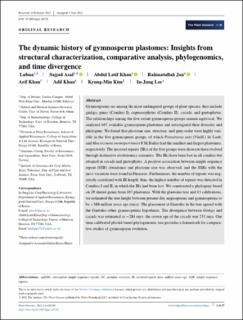| dc.contributor.author | Lubna, Lubna | |
| dc.contributor.author | Asaf, Sajjad | |
| dc.contributor.author | Khan, Abdul Latif | |
| dc.contributor.author | Jan, Rahmatullah | |
| dc.contributor.author | Khan, Arif | |
| dc.contributor.author | Khan, Adil | |
| dc.contributor.author | Kim, Kyung-Min | |
| dc.contributor.author | Lee, In-Jung | |
| dc.date.accessioned | 2022-07-15T09:05:54Z | |
| dc.date.available | 2022-07-15T09:05:54Z | |
| dc.date.created | 2021-09-28T15:37:29Z | |
| dc.date.issued | 2021 | |
| dc.identifier.citation | Lubna, Asaf, S., Khan, A. L., Jan, R., Khan, A., Khan, A., Kim, K. M., & Lee, In-J. The dynamic history of gymnosperm plastomes: Insights from structural characterization, comparative analysis, phylogenomics, and time divergence. The Plant Genome, 14(3): e20130. doi: | en_US |
| dc.identifier.issn | 1940-3372 | |
| dc.identifier.uri | https://hdl.handle.net/11250/3005694 | |
| dc.description.abstract | Gymnosperms are among the most endangered groups of plant species; they include ginkgo, pines (Conifers I), cupressophytes (Conifers II), cycads, and gnetophytes. The relationships among the five extant gymnosperm groups remain equivocal. We analyzed 167 available gymnosperm plastomes and investigated their diversity and phylogeny. We found that plastome size, structure, and gene order were highly variable in the five gymnosperm groups, of which Parasitaxus usta (Vieill.) de Laub. and Macrozamia mountperriensis F.M.Bailey had the smallest and largest plastomes, respectively. The inverted repeats (IRs) of the five groups were shown to have evolved through distinctive evolutionary scenarios. The IRs have been lost in all conifers but retained in cycads and gnetophytes. A positive association between simple sequence repeat (SSR) abundance and plastome size was observed, and the SSRs with the most variation were found in Pinaceae. Furthermore, the number of repeats was negatively correlated with IR length; thus, the highest number of repeats was detected in Conifers I and II, in which the IRs had been lost. We constructed a phylogeny based on 29 shared genes from 167 plastomes. With the plastome tree and 13 calibrations, we estimated the tree height between present-day angiosperms and gymnosperms to be ∼380 million years ago (mya). The placement of Gnetales in the tree agreed with the Gnetales–other gymnosperms hypothesis. The divergence between Ginkgo and cycads was estimated as ∼284 mya; the crown age of the cycads was 251 mya. Our time-calibrated plastid-based phylogenomic tree provides a framework for comparative studies of gymnosperm evolution. | en_US |
| dc.language.iso | eng | en_US |
| dc.publisher | Wiley | en_US |
| dc.rights | Navngivelse 4.0 Internasjonal | * |
| dc.rights.uri | http://creativecommons.org/licenses/by/4.0/deed.no | * |
| dc.title | The dynamic history of gymnosperm plastomes : Insights from structural characterization, comparative analysis, phylogenomics, and time divergence | en_US |
| dc.title.alternative | The dynamic history of gymnosperm plastomes: Insights from structural characterization, comparative analysis, phylogenomics, and time divergence | en_US |
| dc.type | Peer reviewed | en_US |
| dc.type | Journal article | en_US |
| dc.description.version | publishedVersion | en_US |
| dc.rights.holder | © 2021 The Authors | en_US |
| dc.subject.nsi | VDP::Matematikk og Naturvitenskap: 400::Zoologiske og botaniske fag: 480::Planteanatomi: 491 | en_US |
| dc.subject.nsi | VDP::Matematikk og Naturvitenskap: 400::Basale biofag: 470::Genetikk og genomikk: 474 | en_US |
| dc.subject.nsi | VDP::Matematikk og Naturvitenskap: 400::Zoologiske og botaniske fag: 480::Plantefysiologi: 492 | en_US |
| dc.source.pagenumber | 17 | en_US |
| dc.source.volume | 14 | en_US |
| dc.source.journal | The Plant Genome | en_US |
| dc.source.issue | 3 | en_US |
| dc.identifier.doi | 10.1002/tpg2.20130 | |
| dc.identifier.cristin | 1939988 | |
| dc.relation.project | Korean Government: NRF-2021M3E5E6022715 | en_US |
| dc.relation.project | National Research Foundation of Korea: 2017R1D1A1B04035601 | en_US |
| dc.source.articlenumber | e20130 | en_US |

